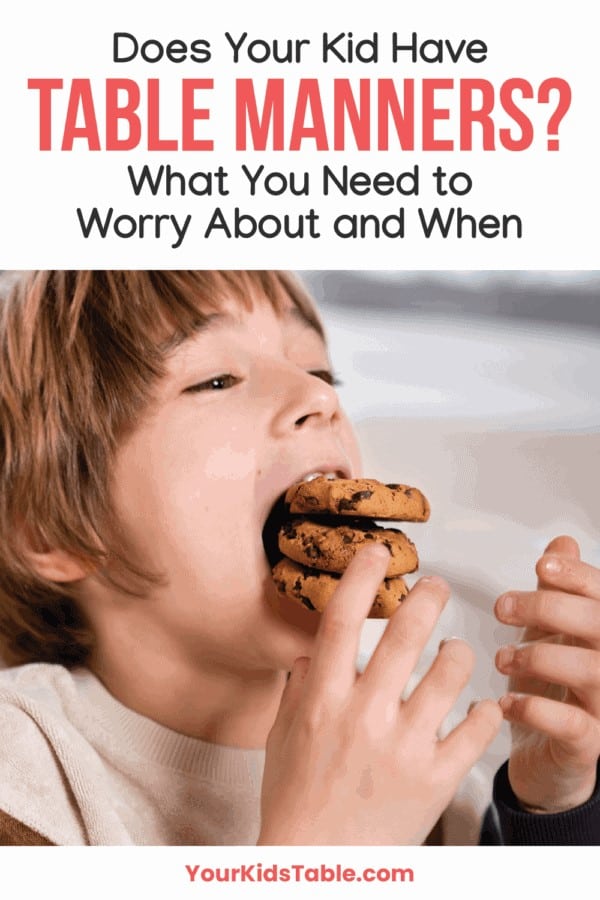Learn what kids table manners your child “should” have and at what age. Plus, when you should consider exceptions to some of the most popular kids table manners!
Lay your napkin on your lap, put your pinky out when taking a polite sip of water, and place your fork upside down on your plate when you’re finished.
That’s proper table etiquette after all. Should your child follow those rules?
Probably not, but surely there are kids table manners they should follow… right?
You Should Know Many Table Manners are Cultural!
First of all, table manners are in large part cultural. While it’s considered impolite to eat with your fingers from a common bowl in the middle of the table, that is quite common in many countries around the world.
While a few generations ago, kids were expected to follow table manners quite closely or receive punishment, I think today it’s important to teach our kids that other families may eat differently, as we teach them table manners.
That way they can be respectful and accommodating to the different ways families may eat as they grow up.
Working on Kid’s Table Manners is Fine, BUT….
Wanting some civility and manners, that are common in western cultures, is okay. But, there are some circumstances when enforcing table manners on kids can be harmful to their eating.
For example, it may be unthinkable to let your child eat with their fingers, but if they are a picky eater with sensitivity to textures, it’s actually a REALLY GOOD thing for them to eat with their hands, even if they’re 7 years old.
I’ll explain more in minute, but my point is that, as an occupational therapist, I strongly believe that table manners shouldn’t be the primary focus when we’re feeding our kids.
Unfortunately, we tend to start worrying about table manners even when we feed our babies, as we carefully wipe their face after every bite. But, babies need to get messy so they aren’t sensitive to those textures when they’re 7 years old. Read more about why babies should get messy.
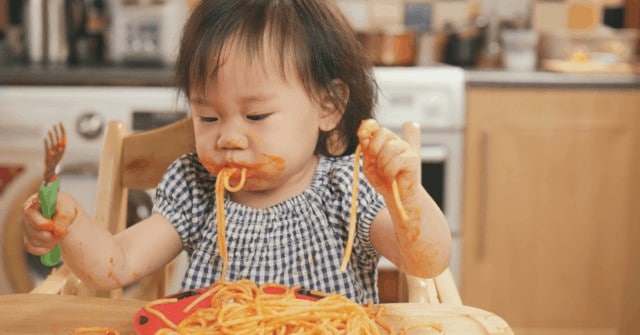
Affiliate links used below. See our full disclosure.
What Table Manners Should Kids Have?
Kids table manners shouldn’t be the first priority, but that doesn’t mean to totally ignore them either. So, which table manners should you work on with your kid? Below are 11 of the most important, but I’ll also list the exceptions for when they shouldn’t be enforced as well as the age you can expect your child to master them.
Kids Table Manner #1: Wash Hands Before Eating
Kids touch everything, and teaching your child to wash their hands before they eat isn’t just a good table manner, it’s also good hygiene. This table manner doesn’t interfere with picky eating, sensory needs, or any other developmental challenges your child has, so it’s a good table manner to put in practice.
Exception to following this table manner: If your child is spontaneously about to pop a new food into their mouth from the garden or when you’re cooking dinner, don’t stop them because they didn’t wash their hands first. If you do, they’ll likely not pick up that cherry tomato again.
Age child can complete: You can start washing your babies hands when they come to eat, and kids by the age of 2 should be able to complete it independently as long as they can reach the sink and faucet. I love this faucet extender and foot stool to help the littlest kids!
Kids Table Manner #2: Sitting at a Table for Meals
Kids can’t eat well and learn to eat new foods if they’re walking around and eating, or eating on their own in front of the TV.
This can be a hard for some kids. Head to How to Keep Your Kid Seated at the Table, if you need more help. We have a free printable there too!
Exception to following this table manner: If you’re child has sensory needs and has A LOT of difficulty sitting still, you could allow them to stand or sit on a yoga ball. Or, if you’re child is an extreme picky eater, they may need time to get used to eating at the table and you might just focus on one meal a day.
Age child can complete: Start feeding your child at the table as a baby, and children of all ages can sit at the table.
Kids Table Manner #3: Using Utensils to Eat
In Western cultures, using utensils to eat is viewed as polite. It’s also a great fine motor skill for kids to work on. However, as I already mentioned, I don’t think this kid’s table manner needs followed explicitly, especially under the age of 8. Kids are still exploring and learning about the textures of food.
But, if a child can’t use utensils because they don’t know how, that’s different.
In that case, you’ll want to teach them, so they’re capable of using a spoon, fork, or knife. See the Teach Your Child to Self-Feed guide to learn tips.
Exception to following this table manner: If your child is a picky eater, encourage them to use their utensils at times, but if they’re eating without it, I’d let go of enforcing it until their eating improves.
Age child can complete: Give babies a spoon to practice with, but don’t expect your child to learn how to use a spoon and then fork until 18-21 months. If they still can’t by 24 months, then talk to your doctor about an OT evaluation. Look for your child to use a butter knife to cut food around 4-5 years old.
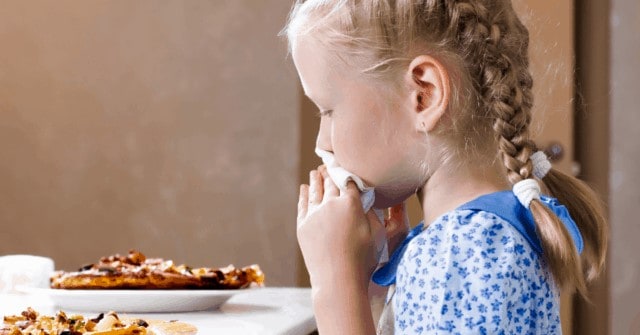
Kids Table Manner #4: Wipe Your Face with a Napkin
Give your child a napkin next to their plate at every meal. This is actually helpful for kids that don’t like to get messy because they’re tactile defensive. It could help them eat more if they know they have a napkin to clean themselves up. For babies and toddlers, I wouldn’t bother having them wipe their face until the end of the meal.
For kids that are 6+ years old, you can discreetly ask them to wipe their face if they have a big glob of ketchup on their cheek. I’d also talk to them about paying attention to the feeling of food on their face while they’re eating and if they feel something to wipe it off.
Then, teach your child to use their napkin to swipe back and forth across their mouth 3 times before they leave the table.
Exception to following this table food manner: If kids are picky eaters and they have a messy face, no matter how old they are, let it go until the end of the meal. It’s not important right now.
Age child can complete: Kids as young as 1 year old can be taught to wipe their face off with a napkin at the end of the meal. You can expect kids to do this with practice by the age of 2.
Kids Table Manner #5: Cover Mouth for Burping and Say Excuse Me
I have 3 boys, so this is a big one in my house. I’m cringing right now thinking of the impromptu burping competitions that have happened around my table. In my case, my kids have needed frequent reminders that if they need to burp to:
- Tuck their chin
- Close or cover their mouth
- Say, “Excuse me”.
There’s nothing wrong with needing to burp, but it’s loud and quite frankly rude when someone burps as loud as they can in the middle of a meal.
Exception to this kids table manner: If you have a picky eater and they burp incidentally, I may address it briefly. But, again, I don’t want to make too big of a deal about it if they’re eating well. You can always teach them the 3 steps after the meal.
Age child can complete: You can start telling kids at 1 year old to close or cover their mouth, and by 3 years old, kids are capable of following this table manner.
Kids Table Manner #6: Don’t Reach, Pass the Food
If your child wants a second helping, teach them to ask for the food to be passed instead of reaching across the table. This will take a lot of repetition for some kids.
Exception to this kids table manner: The only exception again is for the picky eaters. If your child doesn’t usually ask for seconds, and they reach for more broccoli, then it may not be the moment to enforce the “can you please pass the broccoli,” rule!
Age child can complete: Kids can actually begin passing light weight bowls with repeated practice by 18 months!
Kids Table Manner #7: Say Please and Thank You when Being Served
The last thing any parent wants is for their kid to be eating in someone else’s house on a playdate and appear rude. Give reminders to your child to say please when they’re asking for food or drink during a meal, and thank you when someone serves them.
Be careful not to let reminding your child to say please and thank you make mealtime a negative experience though.
Exception to this kids table manner: Choose your battles, if your kid is having a rough time sitting still, focusing, or eating, it’s okay not to enforce please and thank you for that meal. Also, you can practice please and thank you all during the day, if mealtime is difficult for your child.
Age child can complete: Kids can learn this as soon as they’re talking, but look for consistent use by 3-5 years old.
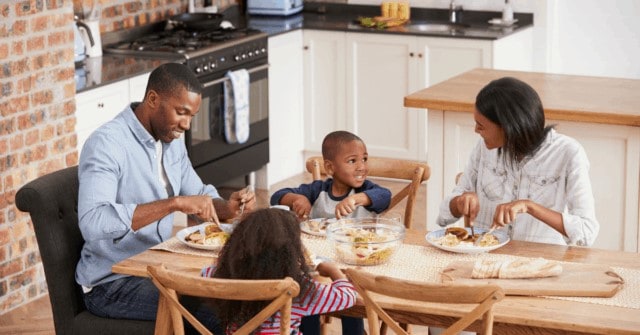
Kids Table Manner #8: Chew With Your Mouth Closed
Nobody wants to watch food being chewed in someone else’s mouth. Some kids will naturally keep their mouths closed and this is barely an issue. For other kids, it’s not until they’re older and trying to eat fast and talk at the same time.
Either way, if your child is chewing with their mouth open, give them reminders to close their mouth because others can see what they’re eating.
I’ve also found it helpful to demonstrate what chewing with your mouth open looks and sounds like. That’s often a powerful visual for kids that are 5 or older.
Exception to this kids table manner: If your child has an oral motor difficulty, it may be too challenging for them to chew with their mouth closed. Once their skills improve, you can begin to ask them to keep their mouth closed.
Age child can complete: Begin telling your child at 18 months to close their mouth if they don’t have any feeding difficulties and continue to reinforce as needed.
Kids Table Manner #9: Don’t Stuff Too Much Food in Your Mouth
Some kids stuff a ton of food in their mouth because they’re in a rush or don’t feel like cutting up their food. In this case, you want to remind them to slow down and take bite sized pieces of food and chew before taking their next bite.
But some kids stuff because of a sensory processing reason. Sometimes kids can’t feel where a single piece of food is in their mouth very well, so they stuff a bunch in. Other times, they just like the pressure on their cheeks from all that food. If this is the case, they may need some sensory strategies with eating.
Exceptions to this kids table manner: It’s not safe for kids to stuff too much in their mouth, so it’s important to address it no matter what the cause is.
Age a child can complete: Address over stuffing at any age it pops up, even for babies.
Kids Table Manner #10: Clean Up Your Plate
Having your child put their plate by the sink or in the dishwasher when they’re finished eating is a great way to have them learn responsibility and participate in the meal further by helping YOU.
But, it also solidifies that the meal is over.
This is really helpful if you have a picky eater that frequently comes back to the table to try and eat again 20 minutes after the meal ended.
Exception to this kids table manner: Kids that are under 2 might have a hard time clearing their plate.
Age a child can complete: I start working on it as soon as a child has a plate to eat off of. If they’re still in a high chair, they can help you carry the tray over, but otherwise, they’ll likely be 2-3 years old before they can do this independently.
Affiliate links used below. See our full disclosure.
Kids Table Manner #11: Do Not Speak Negatively About Food*
This is a BIG one, and is one of the most important kids table manners on this list. It will also likely hold up in any culture around the world. From the time my kids were very little, I’ve been very clear that we don’t speak negatively about food (that’s the OT/feeding therapist in me).
Picky eaters will say they don’t like a food or that it smells or looks gross. All of that is fine, and they can feel those things, but they won’t be talked about at the table.
This is critical because that negative talk just continues to reinforce their dislike of a food. It also could affect whether or not another child at the table eats a food. Not to mention it could be hurtful to whomever cooked or prepared the meal.
My husband and I don’t talk negatively about foods either. Even though I don’t like olives, I’d never say, “Ick, I don’t know how you eat those things,” while we ate a meal.
Exceptions to this kids table manner: If your child has anxiety about food, they may be trying to communicate that a food is giving them a lot of discomfort. You’ll want to teach your child to just ask for a divided plate or for the food to be moved away. Then, after the meal, you can talk about what’s difficult for them about the food.
Age child can complete: Start teaching your child negative food talk is unacceptable the first time you hear it come out of their mouth!
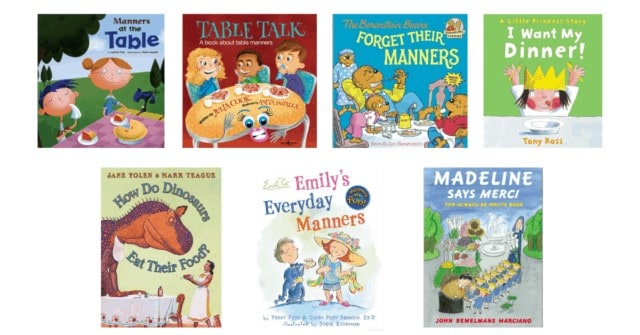
Children’s Books About Table Manners
Want to reinforce table manners with your child? Reading a picture book together is a great way to introduce politeness and manners at meals:
How Do Dinosaurs Eat Their Food?
The Berenstain Bears Forget Their Manners
Want 7 Days of Kids Meals for Free?
If you’re looking for some inspiration, grab our 7-Day Meal Plan for Kids by clicking the link below. We’ll send it right to your inbox. You can start using it today!!
More about Kid’s Eating
How to Get Kids Eating at Meals Instead of Snacking All Day
Gardening with Kids: Improve Your Kid’s Eating!
7 Mealtime Rituals That Keep Kids at the Table Longer
5 Fun Ways to Grow Closer to Your Child During Dinner
Alisha Grogan is a licensed occupational therapist and founder of Your Kid’s Table. She has over 17 years experience with expertise in sensory processing and feeding development in babies, toddlers, and children. Alisha also has 3 boys of her own at home. Learn more about her here.
